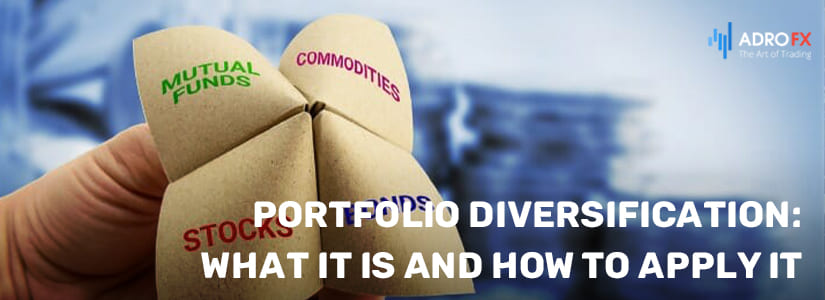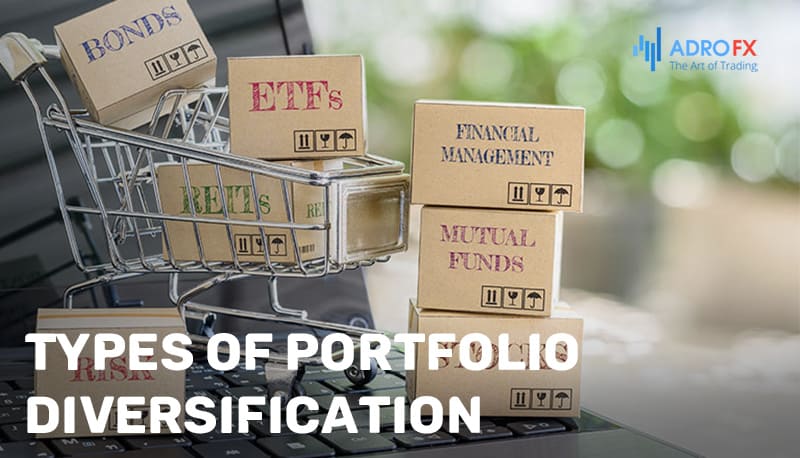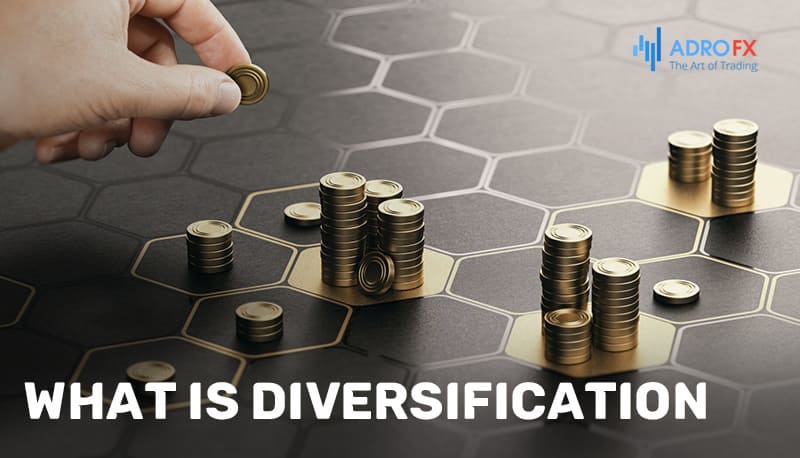Portfolio Diversification: What It Is and How to Apply It

In trading, it is important to manage your investments wisely and not to bet on one particular financial instrument, because at any moment the price of an asset can change dramatically. No matter how stable the forecasts are. This is the mistake made by many beginning investors — they buy shares for 30-50% of the deposit and wait for earnings.
Portfolio diversification will help preserve capital and protect it when prices of some assets drop sharply due to sudden economic or political news. Today we will examine in detail what investment portfolio diversification is, what principles it uses and how it can help preserve a trader's capital.
What Is Diversification
Asset allocation in an investment portfolio or portfolio diversification is the purchase of different financial instruments or the practice of allocating investments based on projected returns and risks: stocks, metals, currencies, bonds, ETF funds (funds formed by a management company that includes a specific set of company shares assembled according to diversification principles) or options. That is, the investor or trader, to balance the risks and volatility of different categories of financial instruments, must buy assets in special proportions or ratios derived by practicing financial analysts.
This means that you should not invest only in buying stocks: among securities, some issuers can strongly react to political or economic news, which can lead to the closure of the order by Stop Loss. Then the price will return to its previous trend, but the trade will be closed with a loss. Thus, different assets yield different returns. For example, some shares will return 100-200%, while bonds will return 10-25% per annum for the same period. The higher the yield, the higher the risks.
Why Diversification Matters
Portfolio diversification helps investors weather market turbulence. For example, someone who owns only airline stocks will suffer if oil prices soar. The same thing works in the opposite case: you only have airline stocks in your portfolio, and then a coronavirus happens, and the number of flights drops dramatically. Accordingly, your portfolio becomes cheaper.
In recent years, there has been an explosion in the growth of services that perform portfolio diversification for the investor. These funds can provide access to dozens of different companies in several sectors and countries and eliminate the need to buy stocks individually.
What Is an Aggressive Portfolio and Why Is It Bad?
In practice, competent diversification of an investment portfolio is a choice of trading strategy or trader's behavior. Depending on the type of trading instruments acquired by a trader, the type of investor is determined.
In general, there are such styles of investing (capital diversification):
Conservative style — quiet trading or long-term investing, without placing orders too frequently, this includes instruments with minimal risks: shares of the most reliable and stable companies ("blue chips").
Moderate — in addition to the most conservative instruments, investors include more liquid securities - corporate bonds and ETFs.
Aggressive — active trading using various trading styles. The trader works with the most volatile instruments that bring return up to 1000% from trade, such as options, IPO (initial issue of shares after which the securities are available to each participant on the stock exchange), currency pairs, or cryptocurrencies. The risks of such a portfolio are maximum, as well as possible gain. This style of trading requires constant involvement in the process.
The main difference or characteristic underlying the division of trading styles or portfolios is the set of instruments an inves
What Does an Aggressive Portfolio Include?
An aggressive portfolio is comprised of the most liquid and volatile financial instruments that allow attaining a yield even within one trading session: a trade does not have to be held for weeks, months, or years as it is done in a moderate or conservative portfolio. The more fluid the instrument, the shorter the trade can be to bring in a guaranteed return.
Pros of an aggressive portfolio:
High yield (depending on the selected instruments, it is possible to earn up to 50%, 100%, or more);
Return can be earned in a short period (most trades are closed within a day or several trading sessions).
Cons of the aggressive type of investing:
This approach can hardly be called investing — it is speculative trading;
Requires active participation of the trader or transfer to the management of a professional trader.
High level of risks (direct dependence on the possible level of gain).
Experts do not recommend getting involved in speculative trading and to form an aggressive portfolio of high-liquid securities. If you want trading to be exciting, satisfying, and financially successful, it's important to choose a portfolio with an optimal mix and correlation of financial instruments.
What Portfolio is Considered Optimal?
We have considered that there are 3 main types of portfolios, which differ in terms of risk, the composition of assets, and returns.
A conservative portfolio is considered the most optimal portfolio. The main goal is to preserve capital and obtain stable earnings with minimal risks. In the composition of the conservative portfolio experts include the following types of assets:
- Shares in the category of the so-called "blue chips" – are securities issued by the largest companies. The main difference is that the securities have low volatility (price volatility) and show stable growth. For example, Microsoft or Coca-Cola.
- Real estate in western countries with low inflation – the U.S., Germany, or France.
- Precious metals.
- Deposits in major banks rated A or higher.
A conservative portfolio yields returns of up to 5-15% per annum and is designed for a long-term investment: 3-5 years. The investor receives income not only from the gradual growth of securities or asset quotes but also from coupon or dividend payments.
Types of Portfolio Diversification

To understand portfolio diversification and the ability to choose the right earnings potential assets, let's understand the ways or criteria by which professionals form types of portfolios.
By Asset
The first thing each beginning investor or trader coming to the stock market gets acquainted with is the types of financial instruments or assets they will have to work with. A portfolio can consist of a set of different assets in different proportions. It works like this: when bonds go up, some stocks start to fall in value and vice versa.
The most straightforward are stocks, bonds, bank deposits, or ETFs.
The most stable and reliable instruments are federal bonds, bonds issued by the U.S. government, and corporate bonds of major companies that pay a stable coupon yield (the interest that the issuer pays on the bonds). Such assets should be present in the portfolio of any investor to diversify risks from working with more beneficial and volatile instruments. The optimal mix is considered up to 30%-50% of the total portfolio, depending on the investor's goals and investment profile.
The portfolio of an experienced trader or investor may include the most difficult-to-master and highly lucrative instruments - derivatives such as futures and options.
By sectors of the economy
Another principle of securities selection and portfolio formation is distribution according to economic sectors.
The most popular economic sectors that are found on the stock exchanges of the world are as follows:
- Retail (retail trade);
- Oil and gas;
- IT;
- Telecommunications;
- Real estate and construction;
- Finance;
- Transport;
- Pharmaceuticals.
You can buy stocks from companies in each sector of the economy to spread risk across your portfolio. It helps in times of crisis: some sectors will suffer more than others. As an example, the COVID-19 pandemic hit many sectors of the economy: the airline industry or the oil and gas industry. Other sectors, on the contrary, were not affected at all, which helped the stocks of companies involved in such sectors as high retail (grocery stores), IT, or pharmaceuticals.
By country
A trader can buy securities of their country. With time and increasing experience in financial markets, the investor begins to invest in the economy of other countries - so there is a diversification of the portfolio by country. To work with securities of different countries or indices is to level out geopolitical and economic risks.
For example, to invest in the US economy, you can use the S&P500 index, Japan's economy is characterized by the Nikkei 225, while Singapore's main stock index, the Straits Times Index (STI), contains shares of the 30 most successful companies.
By currency
Buying foreign currencies from different countries protects capital from inflation and allows you to benefit from currency fluctuations. The most promising currencies for investment are the traditional euro or the U.S. dollar. In times of crisis, investors invest in safe haven currencies such as the Japanese yen or the Swiss franc.
By risk
In this allocation of capital, an investor chooses securities according to their degree of safety or risk.
The safest and lowest-risk assets are federal bonds. Then come stocks or corporate bonds, funds or futures, and options.
By time
This diversification involves combining assets by time action. A smart mix of short-term securities and long-term securities will help you raise capital more quickly. If short-term instruments close with a gain. A part of the income from them can be reinvested in other assets - long-term assets. Examples of short-term instruments are stocks, deposits, or cryptocurrency. Long-term instruments to invest in - ETFs, real estate, long-term bank deposits, or precious metals.
Pros and Cons of Portfolio Diversification
Let's name some of the advantages of diversification:
- Reduced losses. If you invest all of your funds in only one asset, it can be disastrous, especially in the event of a recession.
- New opportunities. If a trader is really interested in investing but doesn't want to put all the capital into one asset, portfolio diversification allows limited exposure.
- Long-term growth. Asset diversification means investors are less likely to miss out on explosive growth in one particular asset class. Stocks may yield the most in one year; fixed-income instruments may dominate the next. A well-diversified portfolio can help cover all the major opportunities.
There are also some disadvantages to diversification:
- Returns may be smaller. In the short term, an investor with a diversified portfolio may miss out on high returns because their capital is invested in low-risk assets.
- This is difficult. Building a perfectly balanced portfolio is not easy and can take a long time. Investments with too little or too much risk can have disappointing consequences.
- Higher costs. Buying a mass of assets means higher costs.
Conclusion
In a nutshell, diversification is an expansion of the range of capital investments, and, at the same time, it is the main weapon of an investor in the fight against risk. But an investor must remember that diversification is not a panacea; no one is immune from the risk of losses. Moreover, by reducing risks, we can increase losses in the short term, so we need to approach the process of capital allocation with caution.
About AdroFx
Established in 2018, AdroFx is known for its high technology and its ability to deliver high-quality brokerage services in more than 200 countries around the world. AdroFx makes every effort to keep its customers satisfied and to meet all the trading needs of any trader. With the five types of trading accounts, we have all it takes to fit any traders` needs and styles. The company provides access to 115+ trading instruments, including currencies, metals, stocks, and cryptocurrencies, which make it possible to make the most out of trading on the financial markets. Considering all the above, AdroFx is the perfect variant for anyone who doesn't settle for less than the best.









